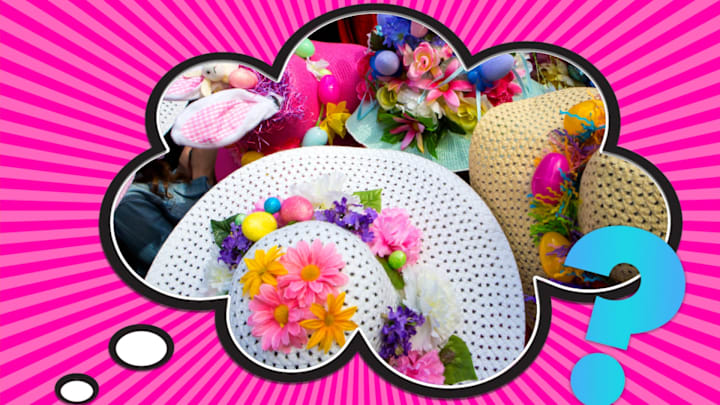Head to New York’s Fifth Avenue on Easter Weekend and you’ll find what looks like an explosion of life-sized confetti. It’s the annual Easter Parade and Bonnet Festival, and “the only requirement” to participate, notes a guide, “is a bonnet, the more whimsical the better.”
But what exactly are Easter bonnets and where did they come from?
From New Clothes to Hats on Parade

Western culture has linked Easter with new threads for centuries. In Europe, people donned fresh outfits on the holiday as a symbol of renewal and rebirth. One piece of folklore from 1830 warns that “Every person must have some part at least of his dress new on Easter Sunday, or he will have no good fortune that year.”
In the U.S., the tradition took on a distinctively performative bent in the years following the Civil War. It was already common in New York for wealthy city-dwellers to spill out onto the streets after church to see and be seen in their Sunday best. And if Fifth Avenue was their weekly red carpet, Easter Sunday was their Met Gala; it was the day to show up in the boldest, most fashion-forward outfit you could muster.
Perhaps no part of an Easter Sunday outfit was more important than the hat. Women already wore hats in public; in the late 1800s, those head coverings were often bonnets, a name that came to encompass any Easter hat. The holiday presented an excellent opportunity to buy the first non-winter hat of the year.
People opted to get whimsical and extravagant with their holiday headpieces. In the late 19th century, volume was in vogue. A magazine print from 1897 featured a large Easter bonnet adorned with flowers floating above a group of people and the caption, “The easter hat throws everything else in the shade.” With size came with risk, though. In 1889, a woman in Chicago was alarmed to discover that “the nodding plumes of a new Easter bonnet” had been set on fire by the end of a nearby cigar.
An Enduring Tradition
Even as styles morphed, the importance of the hat remained. “It is Time to Plan the Easter Bonnet,” announced a New York Times headline in February 1924. The accompanying article, which filled the majority of a page in the Sunday paper, offered an array of instructional pictures showcasing the latest fashions.
Conformity, however, has never been the point. “The changes of style in gowns are important and permanent,” noted the article. “But the bonnet! That is so … individual a matter.”
Despite waves of alarm over the years that the Easter bonnet is a dying tradition (“Mothers…say that their little girls will never know what it is to wear an Easter bonnet,” lamented a museum curator in 1975), the commitment to over-the-top headwear remains.
Every year on Easter, parades and other hat-showcasing opportunities abound, from the New Orleans Gay Easter Parade to New York’s iconic Easter Parade and Bonnet Festival. Whether you opt for feathers, flowers, or sparkles this Easter, one thing’s for sure: As long as you love your hat, it will always count as Easter finery.
